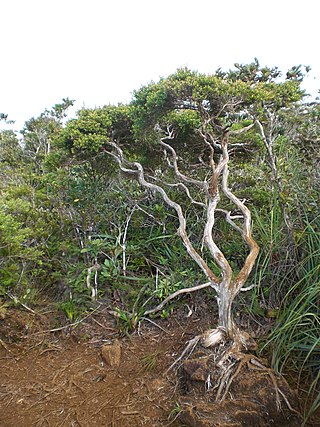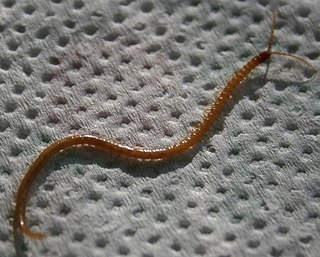Examples

Examples of the cryptozoa include land-planarians, amphipods, pill-woodlice, centipedes, pill-millipedes, thysanurans, false-scorpions and oribatid mites.
Cryptozoa is the collective name for small animals who live in darkness and under conditions of high relative humidity, as in the wet soil underneath rocks, decomposing tree bark etc. [1] [2] Examples include pseudoscorpions, slugs, centipedes and earwigs. The habitat of the cryptozoa allows avoidance of fluctuations of temperature and humidity, which makes the contained range of considerably different species quite remarkable. [3] Moreover, cryptozoa are notable for their inclusion of often unnamed varieties of organisms.
The term "cryptozoic fauna" was originally coined by Arthur Dendy. [4]
Sometimes referred to as the cryptozoic niche, the habitat allowing for cryptozoic life is characterized by a shielding of exterior light sources, with stable and cool temperature and high humidity. Forest humus and leaf litter can provide the necessary conditions for cryptozoic life in part because of the shielding from surrounding trees. Nonetheless, temperate woodlands are not the only ground for such a habitat: the tropics and the desert are often suitable for cryptozoa, such as scorpions or Solifugae. [3]

Examples of the cryptozoa include land-planarians, amphipods, pill-woodlice, centipedes, pill-millipedes, thysanurans, false-scorpions and oribatid mites.

Chaparral is a shrubland plant community found primarily in California, in southern Oregon and in the northern portion of the Baja California Peninsula in Mexico. It is shaped by a Mediterranean climate and infrequent, high-intensity crown fires.

The Bromeliaceae are a family of monocot flowering plants of about 80 genera and 3700 known species, native mainly to the tropical Americas, with several species found in the American subtropics and one in tropical west Africa, Pitcairnia feliciana.

In ecology, edge effects are changes in population or community structures that occur at the boundary of two or more habitats. Areas with small habitat fragments exhibit especially pronounced edge effects that may extend throughout the range. As the edge effects increase, the boundary habitat allows for greater biodiversity.

Centipedes are predatory arthropods belonging to the class Chilopoda of the subphylum Myriapoda, an arthropod group which includes millipedes and other multi-legged animals. Centipedes are elongated segmented (metameric) creatures with one pair of legs per body segment. All centipedes are venomous and can inflict painful stings, injecting their venom through pincer-like appendages known as forcipules, which are actually modified legs instead of fangs. Despite the name, no centipede has exactly 100 pairs of legs; number of legs ranges from 15 pairs to 191 pairs, always an odd number.

Ecological succession is the process of change in the species that make up an ecological community over time.

Tropical rainforests are rainforests that occur in areas of tropical rainforest climate in which there is no dry season – all months have an average precipitation of at least 60 mm – and may also be referred to as lowland equatorial evergreen rainforest. True rainforests are typically found between 10 degrees north and south of the equator ; they are a sub-set of the tropical forest biome that occurs roughly within the 28-degree latitudes. Within the World Wildlife Fund's biome classification, tropical rainforests are a type of tropical moist broadleaf forest that also includes the more extensive seasonal tropical forests.

In ecology, habitat refers to the array of resources, physical and biotic factors that are present in an area, such as to support the survival and reproduction of a particular species. A species habitat can be seen as the physical manifestation of its ecological niche. Thus "habitat" is a species-specific term, fundamentally different from concepts such as environment or vegetation assemblages, for which the term "habitat-type" is more appropriate.

Desert ecology is the study of interactions between both biotic and abiotic components of desert environments. A desert ecosystem is defined by interactions between organisms, the climate in which they live, and any other non-living influences on the habitat. Deserts are arid regions that are generally associated with warm temperatures; however, cold deserts also exist. Deserts can be found in every continent, with the largest deserts located in Antarctica, the Arctic, Northern Africa, and the Middle East.

Troglofauna are small cave-dwelling animals that have adapted to their dark surroundings. Troglofauna and stygofauna are the two types of subterranean fauna. Both are associated with subterranean environments – troglofauna are associated with caves and spaces above the water table and stygofauna with water. Troglofaunal species include spiders, insects, myriapods and others. Some troglofauna live permanently underground and cannot survive outside the cave environment. Troglofauna adaptations and characteristics include a heightened sense of hearing, touch and smell. Loss of under-used senses is apparent in the lack of pigmentation as well as eyesight in most troglofauna. Troglofauna insects may exhibit a lack of wings and longer appendages.

Dwarf forest, elfin forest, or pygmy forest is an uncommon ecosystem featuring miniature trees, inhabited by small species of fauna such as rodents and lizards. They are usually located at high elevations, under conditions of sufficient air humidity but poor soil. There are two main dwarf forest ecosystem types, involving different species and environmental characteristics: coastal temperate and montane tropical regions. Temperate coastal dwarf forest is common for parts of Southern California. Montane tropical forests are found across tropical highlands of Central America, northern South America and Southeast Asia. There are also other isolated examples of dwarf forests scattered across the world, while the largest dwarf forest is found in the Philippines.

The sandhill dunnart is a species of small carnivorous Australian marsupial of the family Dasyuridae. It is known from four scattered arid areas of Australia: near Lake Amadeus in Northern Territory, the central Eyre Peninsula in South Australia, the southwestern edge of the Great Victoria Desert in Western Australia, and at Yellabinna in South Australia.

Polylepis is a genus comprising 28 recognised shrub and tree species, that are endemic to the mid- and high-elevation regions of the tropical Andes. This group is unique in the rose family in that it is predominantly wind-pollinated. They are usually gnarled in shape, but in certain areas some trees are 15–20 m tall and have 2 m-thick trunks. The foliage is evergreen, with dense small leaves, and often having large amounts of dead twigs hanging down from the underside of the canopy. The name Polylepis is, in fact, derived from the Greek words poly (many) plus letis (layers), referring to the shredding, multi-layered bark that is common to all species of the genus. The bark is thick and rough and densely layered for protection against low temperatures. Some species of Polylepis form woodlands growing well above normal tree line within grass and scrub associations at elevations over 5000 m; which makes Polylepis appear to be the highest naturally occurring arboraceous angiosperm genus in the world.
Altitudinal zonation in mountainous regions describes the natural layering of ecosystems that occurs at distinct elevations due to varying environmental conditions. Temperature, humidity, soil composition, and solar radiation are important factors in determining altitudinal zones, which consequently support different vegetation and animal species. Altitudinal zonation was first hypothesized by geographer Alexander von Humboldt who noticed that temperature drops with increasing elevation. Zonation also occurs in intertidal and marine environments, as well as on shorelines and in wetlands. Scientist C. Hart Merriam observed that changes in vegetation and animals in altitudinal zones map onto changes expected with increased latitude in his concept of life zones. Today, altitudinal zonation represents a core concept in mountain research.

A eurytherm is an organism, often an endotherm, that can function at a wide range of ambient temperatures. To be considered a eurytherm, all stages of an organism's life cycle must be considered, including juvenile and larval stages. These wide ranges of tolerable temperatures are directly derived from the tolerance of a given eurythermal organism's proteins. Extreme examples of eurytherms include Tardigrades (Tardigrada), the desert pupfish, and green crabs, however, nearly all mammals, including humans, are considered eurytherms. Eurythermy can be an evolutionary advantage: adaptations to cold temperatures, called cold-eurythemy, are seen as essential for the survival of species during ice ages. In addition, the ability to survive in a wide range of temperatures increases a species' ability to inhabit other areas, an advantage for natural selection.

Hemilepistus reaumuri is a species of woodlouse that lives in and around the deserts of North Africa and the Middle East, "the driest habitat conquered by any species of crustacean". It reaches a length of 22 mm (0.87 in) and a width of up to 12 mm (0.47 in), and has seven pairs of legs which hold its body unusually high off the ground. The species was described in the Description de l'Égypte after the French Campaign in Egypt and Syria of 1798–1801, but was first formally named by Henri Milne-Edwards in 1840 as Porcellio reaumuri. It reached its current scientific name in 1930 after the former subgenus Hemilepistus was raised to the rank of genus.

Montane ecosystems are found on the slopes of mountains. The alpine climate in these regions strongly affects the ecosystem because temperatures fall as elevation increases, causing the ecosystem to stratify. This stratification is a crucial factor in shaping plant community, biodiversity, metabolic processes and ecosystem dynamics for montane ecosystems. Dense montane forests are common at moderate elevations, due to moderate temperatures and high rainfall. At higher elevations, the climate is harsher, with lower temperatures and higher winds, preventing the growth of trees and causing the plant community to transition to montane grasslands and shrublands or alpine tundra. Due to the unique climate conditions of montane ecosystems, they contain increased numbers of endemic species. Montane ecosystems also exhibit variation in ecosystem services, which include carbon storage and water supply.

Geophilus flavus is a terrestrial, soil-dwelling, species of centipede in the Geophilidae family. G. flavus occurs in a range of habitats across central Europe, North America, Australia and other tropical regions. Geophilomorph centipedes, like centipedes generally, are primary predators, hunting predominantly in underground soil burrows or above ground leaf litter. Their consumption behaviours are influenced by environment and seasonal factors. Given their lack of economic value and marginal medical significance, G.flavus remains largely understudied in mainstream research. Some recent studies have detailed the evolutionary development of G.flavus and Geophilidae generally, illustrating developed predatory features like forcipule venom glands.

Arthur Dendy was an English zoologist known for his work on marine sponges and the terrestrial invertebrates of Victoria, Australia, notably including the "living fossil" Peripatus. He was in turn professor of zoology in New Zealand, in South Africa and finally at King's College London. He was a Fellow of the Royal Society.

Subterranean fauna refers to animal species that are adapted to live in an underground environment. Troglofauna and stygofauna are the two types of subterranean fauna. Both are associated with hypogean habitats – troglofauna is associated with terrestrial subterranean environment, and stygofauna with all kind of subterranean waters.

Tropical deserts are located in regions between 15 and 30 degrees latitude. The environment is very extreme, and they have the highest average monthly temperature on Earth. Rainfall is sporadic; precipitation may not be observed at all in a few years. In addition to these extreme environmental and climate conditions, most tropical deserts are covered with sand and rocks, and thus too flat and lacking in vegetation to block out the wind. Wind may erode and transport sand, rocks and other materials; these are known as eolian processes. Landforms caused by wind erosion vary greatly in characteristics and size. Representative landforms include depressions and pans, Yardangs, inverted topography and ventifacts. No significant populations can survive in tropical deserts due to extreme aridity, heat and the paucity of vegetation; only specific flora and fauna with special behavioral and physical mechanisms are supported. Although tropical deserts are considered to be harsh and barren, they are in fact important sources of natural resources and play a significant role in economic development. Besides the equatorial deserts, there are many hot deserts situated in the tropical zone.